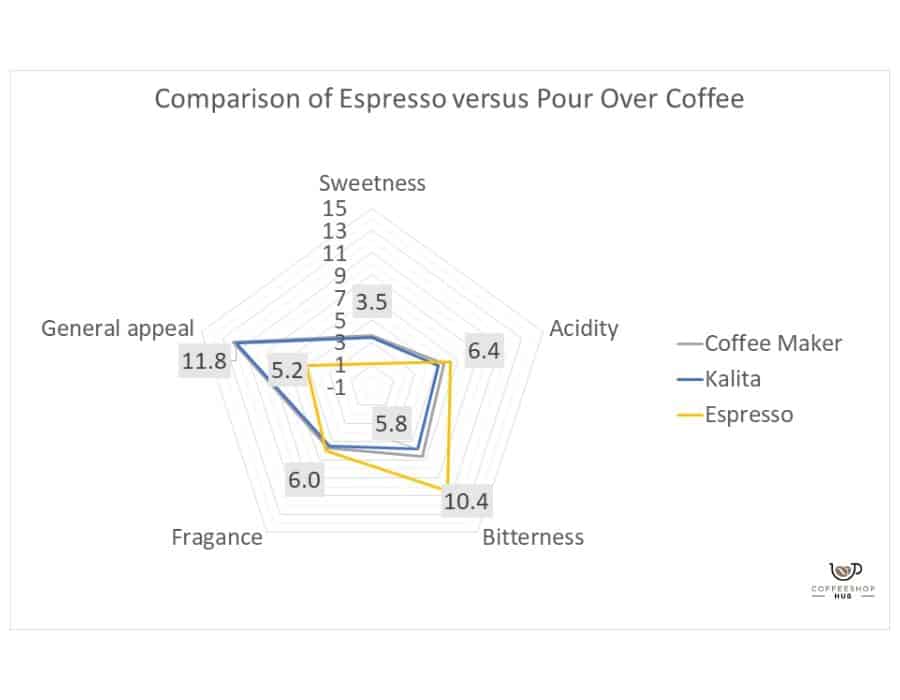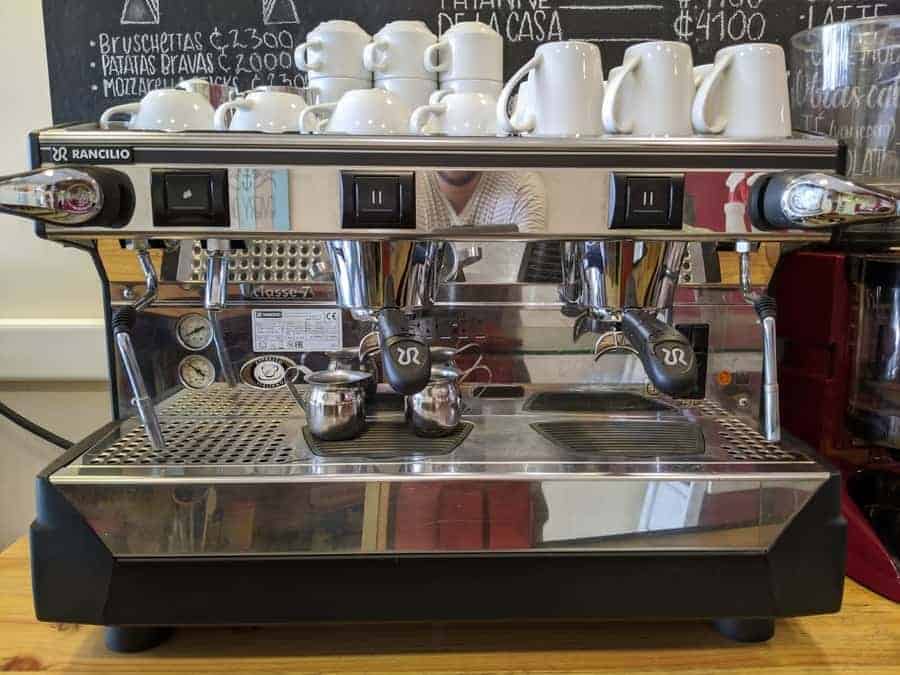
Wondering what is the difference between espresso and pour over coffee?
Maybe you have heard people talk about an espresso. And some people ask what is the difference between espresso and coffee.
When you say “coffee” in this context, you usually mean coffee prepared by a drip or pour over method.
The following is a list of 14 differences between espresso and pour over coffee:
- They are made by different brewing methods
- Type of filter: metal (espresso) versus paper (pour over)
- Type of equipment: espresso is made with an espresso machine and drip coffee with a filter, type of container and hot water.
- Cost of equipment: espresso equipment is far more expensive
- Coffee variations: there are many drinks made from espresso like cappuccino and americano
- Place where it is usually served: espresso coffee is usually served at coffee shops, while drip coffee is usually made at home
- The volume of end coffee liquid: espresso about an ounce, pour over around 12 ounce
- Taste: espresso is stronger
- Coffee concentration: espresso is more concentrated
- Preparation time: espresso is faster than drip coffee
- Appearance: espresso has crema on top, while drip coffee does not and looks like a clear coffee drink
- Chemical composition of coffee drink: espresso has more oils than pour over coffee.
- Coffee grind: espresso is made with finer ground coffee than pour over coffee.
- Roasting of coffee: espresso is usually made with darker roast coffee.
Carry along this article to further discuss all this and a lot more.
Brewing methods
Espresso coffee is made by using special machines that are able to heat up water and then pass it at a high pressure through a metal filter that contains the ground coffee. Because the pressure is high the time that the water is in contact with the coffee is low, around 20 to 30 seconds. This type of method is greatly used in coffee shops.
There are many coffee drinks that use espresso as the base, for example americano and capuccino.
A drip or pour over method, on the other hand, brews coffee by passing water through a filter, usually made of paper, that contains the ground coffee. Water passes down by using the force of gravity, and therefore goes down slowly, with a duration of 3 to 4 minutes per cup of coffee. This type of method is greatly used at home because of its simplicity and low cost.

Appearance and chemical composition
According to the Craft Coffee, by Jessica Easto (2017), coffee has four types of compounds:
- Insoluble oils
- Soluble gases
- Insoluble solids
- Soluble solids
Insoluble means that it can not be solved in water, while soluble means it can dissolve in water.
Insoluble oils are trapped by the paper used in drip coffee and therefore are not present on the resulting coffee drink. On the other hand, these substances do pass by the metal filter on the espresso machine, and constitute mainly what is known as the “crema” in the espresso. The crema is the top layer that is seen in americano or espresso made with an espresso machine.
Which one is better?
It all depends on your personal preference. Espresso is a lot stronger in terms of how it feels in your mouth.
According to Easto (2017) the strength of the coffee is related to the ratio of coffee to water. The higher the ratio, the more coffee to water there is and threfore the stronger the coffee will feel in your mouth.
When espresso is made it has a ratio of water to coffee of about 2:1. This means that from 1 part of coffee you have 2 parts of water.
Pour over coffee, or drip coffee as it is also known, on the other hand, is made with a ratio of 12:1 to 15:1. This means that for every 12 to 15 parts of water you have 1 part of coffee. So drip coffee is a lot more diluted. And therefore which one is better highly depends on your preferences.
A small test with consumers to assess perceived differences
We did a small test with 5 people evaluating coffee drinks. These people were not trained panelists, just regular consumers, and this was not a test made for a scientific paper with statistical analysis. We just wanted to get a sense of people’s reactions to different types of coffee brewing methods.
So we prepared an espresso by using a Rancilio espresso machine. We added 18 grams of finely ground coffee. The coffee beans had an origin of Tarrazu, Costa Rica. The coffee was produced by natural process and considered specialty. It was bought whole and ground right before brewing by using a burr mill.
The espresso was prepared by adding pressurized water for 20 seconds. The result was 39 grams of liquid coffee, more than an ounce.
On the other hand, we also brewed coffee by using two different pour over methods: Kalita and coffee maker. The Kalita method used a paper filter while the coffee maker used a permanente filter.
We used the Sensory Lexicon Guide guide to try to get a sense of what sweetness, acidity, bitterness and fragrance was for coffee. This is a guide that aims to unify all over the world the parameters that people use to evaluate coffee, as well as the descriptive words and levels of intensity of parameters.
So we started the session by testing some samples of sugar dissolved in water to assess different levels of sweetness, and then the same for acidity by using drops of lemon in water. Finally we did the same for bitterness with strong coffee and fragrance with ground and whole beans.
During this calibration phase, and although this was not a trained panel, it was very interesting to see that we all had different perceptions on the levels of sweetness, acidity bitterness and fragrance.
I discovered that I was very sensitive to acidity, for it was really easy for me to perceive acidity of a few drops of lemon of water, while others did not perceive them as such.
Like Easto (2017) says, perceived flavor is not objective but subjective, and dependent on many factors such as genetics and personal experience. While some people detect bitterness with ease others do not.
So after some time evaluating samples to understand the terms and levels of each parameter we started testing the brewed coffee.
We served them without telling them what method the coffee was prepared with. We used some random numbers to codify them so we wouldn’t loose track of each.
The following diagram shows the results:

So as you can see, the yellow line represents the results of the evaluation of espresso, while the blue and gray lines represent coffee maker and kalita respectively.
In terms of bitterness, espresso is definitely perceived as stronger than pour over coffee, as you can see it was twice as high in this parameter compared to kalita and coffee maker. Also, in general appeal, both methods of pour over coffee were prefered over espresso coffee.
However, if you would have done this small test in Italy, the results would probably be the other way around, maybe preferring espresso over pour over coffee.
Also, it was a surprise to see that coffee prepared in a coffee maker was not that differently evaluated than kalita.
As someone told me “ you should not judge methods, it depends on what you like, and the most important thing is to enjoy your coffee”.
I for once am very fond of kalita method, and consider it to be better than coffee maker. When I brew coffee on a coffee maker I find it to be more acidic and like it less.
However, this small group of people did not perceive that. So as said before, when we were calibrating ourselves at the beginning of the sesion, I saw that my perception of acidity was more sensible than the rest, and this was taken as well to the perceived acidity of the brewed coffee made with coffee maker in comparison to the one made with kalita method.
In terms of acidity and fragance there was not much difference perceived between all the methods. Finally, when evaluating sweetness, kalita and coffee maker were perceived as more sweet than espresso.
Which one has more caffeine? An espresso or pour over coffee
According to A Coffee Lovers Guide to Coffee, by Shlomo Stern (2015), an espresso cup has about 60 to 140 mg of caffeine. However, a filtered coffee has from 40 to 130 grams. As you can see the range is large between the upper and lower limit, but there is no real difference in terms of caffeine content between the two.
This makes sense, as seen before, espresso coffee is far more concentrated than drip coffee, but the initial amount of ground coffee is similar. So it would make sense to have a similar amount of caffeine at the end.
So, what makes espresso seem stronger than pour over coffee? It is mainly the taste. But also, since there is less volume it is easier for someone to drink two espressos, while it would be more uncommon for someone to have two pour over 12 ounce coffees.
Do you need a special type of coffee to prepare espresso?
Maybe you have seen that some people buy espresso coffee.
What is the difference between espresso and regular coffee beans?
Espresso coffee usually has a darker roast and is more finely ground than regular coffee.
So, there are two main factors that differentiate regular coffee from coffee labeled as for espresso: level of roasting and ground particle size.
Level of roasting
Roasting is the process of submitting the coffee beans to heat during a certain amount of time. This produces chemical reactions on the beans, like Maillard reaction and browning of the sugars and caramels (Easto, 2017). Both of these processes give coffee many of its volatile aromas and flavor.
The longer the roasting process, the more maillard and caramelization occurs, resulting in darker coffees. Darker roasts usually give a stronger, more “roasted” type of flavor. While medium roast gives a smoother, more mild flavor.
In terms of the darkness of the roast you most definitely can make espresso with any type of coffee. The darker the roast of the coffee the more fragile the coffee beans will be. Because coffee made with an espresso machine is so little time in contact with water, than a more fragile structure makes it easier to extract the flavors and volatiles (Hoffmann, 2018 ).
But this does not mean that you can not make espresso using a medium roast coffee. In the end it is mostly related to the end flavor of the coffee and the consumer preferences.
Ground coffee particle size
Now, the grind is another matter. For making coffee with an espresso machine you do require the grind to be finer.
If you have been to coffee shops that pride in delivering great quality coffees, you will see that they have a mill next to the espresso machine.
This type of mill is unique to espresso machines because of the small size particle needed. An espresso machine requires a very fine coffee because of the low time that the water is in contact with the coffee.
Also, the size of the particle determines how fast or slow the water passes through the filter. If you want it to pass by the coffee faster you must make your grind coarser. On the other hand, if you want the water to pass by more slowly you must make your size particle finer.
This is how baristas calibrate the espresso machines: they ground the coffee, then brew it with an espresso machine, and control the amount of coffee liquid that is left at the end while at the same time measuring the amount of time it took them to brew.
How do they determine the time it brews? By carefully looking at the coffee drip and determining when it has changed its appearance, from dark to light. When this happens, the coffee is ready. If you brew it more you can get an over extracted coffee. So the size of the ground coffee is critical for an espresso machine.
For a drip or pour over method, a medium sized coffee is usually the way to go and has been shown to produce the best results.
When you make coffee using this type of method, the time that the coffee is in contact with water is larger than espresso, about 3 to 4 minutes in comparison to 20 to 30 seconds. So if you have a medium ground coffee you have a lesser risk of having an over extracted coffee.
Where can you get an espresso versus a pour over coffee?
Finally, although you can make an espresso at home with other type of equipment, the usual and best way to go is by using an espresso machine. This is far more expensive, at least a few hundred dollars, in comparison to the equipment that is needed to make a pour over or drip coffee.
Also, espresso is really fast to make, about 20 to 30 seconds, in comparison to 3-4 minutes from pour over. So for mainly these two reasons you will most likely find espresso machines in coffee shops, and pour over methods at home.
However, and especially at specialty coffee shops, you can find both methods: espresso and pour over. The first for the fast paced needed coffee, and the second one for having a different coffee experience at your coffee shop.
References:
Easto, Jessica (2017). Craft Coffee: A Manual: Brewing a Better Cup at Home. Chicago. First edition.
Stern, Shlomo (2015). A Coffee Lovers Guide to Coffee.
Hoffman, James (2018). The World Atlas of Coffee: From beans to brewing – coffees explored, explained and enjoyed.
World Coffee Research, 2017. Sensory Lexicon Unabridged Definition and References . Second edition. Texas.



